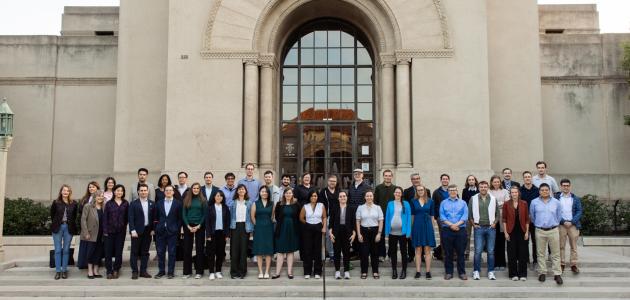Donald Trump’s support among many Latino voters in 2016 and especially 2020 sent shock waves through politics, the media, and academia. While activists, journalists, and scholars are beginning to wake up to the political complexities of Latino communities, Senior Fellow David Leal has been studying this for years. Click here, here, and here to read his recent research about how Latino voters are defying expectations and making up their own minds in presidential elections.
In this conversation, Leal explains how the Latino population has become a major constituency of the American electorate and how it has historically voted in presidential elections over the past half-century. He also discusses the issues that shape Latinos’ participation in party politics and assesses whether and how they may reshape America’s political future.
Leal argues that Latino voters are less different from the political mainstream than both liberals and conservatives assume. While demographic change is significant and has the potential to transform American politics, the reality is that Latinos are acculturating in terms of politics, economics, and many other dimensions of American life. He finds that Latinos want to achieve the American dream, not change it. While Democrats hope, and Republicans fear, that Latinos will shift politics and policy in a progressive direction, he predicts the future will be more complicated. Demographic change is a reality, he says, but it makes no guarantees to any party or ideology.
Rather than assuming a Latino political monolith that is fundamentally different from the mainstream, Leal argues that a better lens to understanding the political future is “the politics of similarity.” This means that Latinos’ beliefs about politics more or less reflect the dynamics that shape the political views of all Americans and are not inevitably distinctive. For instance, he suggests that while Latinos today generally hold more liberal perspectives on economic issues, as their incomes rise and they continue to acculturate into American society, they will become more attracted to principled conservative messages that promote opportunity, entrepreneurship, and limited government.
When did Latinos become a significant voting population in the United States?
Latinos have been in the United States from the start of the nation, but their numbers began to grow considerably because of nineteenth-century foreign policy. The Mexican-American War (1846–48) and the Spanish-American War (1898) added much territory and many people from Mexico and the Spanish empire.
For instance, somewhere between 50,000 to 100,000 Mexicans became Americans overnight at the end of the Mexican-American War. And many “Tejanos” became Americans after Texas rebelled against Mexico and joined the United States. This is why many Mexican Americans say, “We didn’t cross the border, the border crossed us.” And because this border is basically an artificial line in the sand, we should not be surprised by the strong economic, migration, and cultural ties between both countries.
Migration from Mexico and Latin America increased throughout the twentieth century, driven by both the “pull” of the United States and as well as the “push” of difficult economic and political conditions in Mexico and Latin America.
Such population growth does not automatically translate into political influence, however. Even today, as the Latino share of the population continues to grow, many Latinos are under 18 or are not citizens, so they cannot vote.
While media coverage suggests that Latino electoral influence is growing everywhere, the reality is that it varies according to local, regional, and national contexts. Latino voting power is better characterized as “contingent,” meaning it depends on how other populations vote. In a close election, Latinos can in theory make the difference, although the number of times this has happened is not large. We sometimes hear claims that Latinos swung this or that presidential election, but those are big exaggerations.
Also, to look at just Latino votes without considering how Whites, African Americans, Asian Americans, and other groups voted is a mistake. A better approach is to study whether and how Latinos were part of what is called the “winning coalition” of a presidential campaign. How did they, and other voting groups, together help to elect or defeat the candidates?
As a minority group, Latinos are unlikely, by definition, to be singlehandedly responsible for many national or even statewide election outcomes. You can find greater influence at local levels, where in a growing number of locales they are the majority or a significant plurality.
How influential are Latinos in national politics today?
While Latino votes have been influential in certain places and in certain election years, they have yet to transform the balance of partisan power. Historically, Latinos voted in large numbers for fellow Catholic John F. Kennedy in 1960, and Lyndon B. Johnson benefited in his many campaigns from his good relations with Latino leaders in the Texas border counties.
The idea that Latinos may systematically realign American politics is relatively new and has yet to occur. While Latino population growth helped move California and Nevada into the Democratic camp, it benefited Republicans in Florida. Some claim that Latinos may “turn Texas blue,” but even if Democrats start winning in Texas, that would be a result of many political changes, not just growing Latino populations. In 2020, the Pew Center estimated that a third of eligible Texas voters were Latino, which means that the large majority of voters were not Latino. And the Latino eligible voter populations of California and Texas are almost identical percentages, so why is California deep blue and Texas still red? There’s more to the story than just Latino population growth.
We also need to understand that the category of “Latino” is complex. It includes people from many different national backgrounds, ranging from Mexicans to Cubans to Venezuelans. It includes those who recently entered the country and others whose heritage here dates back to the 1800s. Some are more liberal, and some are more conservative.
These groups also have different party ties. Cubans have been more supportive of the GOP, while Mexicans and Puerto Ricans are stronger Democrats. The problem for Democrats is that so many Latino Democrats live in blue or red states, where they have little ability to shape election outcomes. The GOP was lucky that so many Cuban immigrants settled in a battleground state, Florida, and enhanced its political power there.
Will Latinos power a “blue wave” that moves America in a more progressive direction? So far, this has not happened. While many pundits (on both the left and the right) believe “demography is destiny” and that growing minority and immigrant populations will inevitably advance the Democrats, there are good reasons to be skeptical.
What ideologies have historically shaped Latino populations in the United States?
The most important “ideology” is the American dream and core values like freedom, democracy, and capitalism. They have attracted people from around the world for centuries and continue to do so today. As I keep saying, Latinos want to achieve the American dream, not change it.
On social media and cable news, however, you see divisive claims that Latinos are socialists or Marxists. This is all laughable; there is zero evidence in favor of it, and lots of evidence against it. Latinos have a high labor force participation rate, are church going and family oriented, many are social conservatives, and maybe a third voted for Trump—tell me how that’s socialist!
I would not even describe most Latino Democrats as ideologically liberal, not in the way that Manhattan and Hollywood are liberal. As I’ve suggested before, my sense is that they are more of a “New Deal” electorate. I’ve also heard the term “bread and butter” electorate, which captures the same concept. As a lower-income population that often takes difficult jobs with fewer benefits and has less savings, many Latinos are open to a Democratic Party message that says, “We’re from the government, and we’re here to help.” Over time, as Latinos move into the middle class, they may believe that higher taxes and greater regulation are contrary to their interests and consequently reconsider their partisanship.
Some scholars see parallels between the contemporary Latino experience and the previous waves of Italian, Polish, and Irish migrants in the 1800s and 1900s. A book by Joel Perlmann called Italians Then, Mexicans Now shows parallels in socioeconomic progress for both groups across generations. I would add that these earlier immigrant groups were predominantly Catholic and initially joined the lower-skilled rungs of the workforce, but as they gradually acculturated and moved into the middle class, their partisanship diversified. We are also seeing this with Latinos today.
These past ethnic groups were not really on the left as much as they were in favor of New Deal–style tax-and-spend policies at an early stage in their American experience. As the 1960s and 1970s took American politics in a more leftward direction, these ethnic communities were not on board. A White Catholic population that voted overwhelmingly for JFK in 1960 split its vote for another Catholic JFK, John F. Kerry, in 2004.
The story of partisan change is complicated, and I don’t want to simplify it, and changing ideas about race also play a role. But we may well see a Latino electorate that in the not-too-distant future also begins to split its votes between Democrats and Republicans.
What about the “demography as destiny” argument?
This is a theory that both parties believe is true, but the evidence is weak.
As I’ve written before, Democrats hope that growing minority and immigrant populations will transform politics in their favor. Republicans, by contrast, fear they will become electorally irrelevant. My message to both sides is to calm down and realize that demography is not destiny, and that the politics of population change are complicated and have no guaranteed outcomes.
As I just mentioned, Irish and Italian immigrant voters were overwhelmingly Democratic after they reached this nation’s shores. Over time, the Democrats’ appeal to these groups slipped away. They are no longer even a distinctive vote in American politics because they have merged into the mainstream in a classic melting-pot way. I think we are going to see the same trends with Latino voters. This is part of what I meant earlier by a “politics of similarity.”
Some people are surprised that millions of Latinos vote Republican. My answer is, “Well, why do many Americans vote for Republicans? Why should it be different for Latinos?” Latinos, like other Americans, are complex and take a variety of stances on policy issues. We should not expect all Latinos to agree on politics, and recent elections show that many see their home in the GOP.
Republicans get a lot of help from a Democratic Party that is surprisingly clueless about Latino populations. Democrats need Latinos to be more liberal than they really are, and the party is often shocked by, and seemingly in denial about, evidence to the contrary. The party also engages in patronizing outreach, rhetorically supports Latinos during elections but largely forgets them when in power, prays for turnout miracles that never happen, and adopts socialist labels that turn off Latino communities who have experienced socialist regimes.
We might also ask the following challenging questions: If Democrats are so pro-Latino, why is the only Latino governor in California history a nineteenth-century Republican? Why is the only Latino US senator in California history an appointee? Why does red-state Texas currently have more Latino elected statewide officials than does blue-state California? Why are the most pro-Latino presidents in American history George W. Bush and Ronald Reagan? Why was Barack Obama labeled “the Deporter in Chief” by some Latino activists? How did Trump attract so many Latino votes in 2016 and especially in 2020 when liberal pundits and activists said he would drive Latinos en masse to the Democrats?
In sum, we might ask whether Democrats support Latinos, or if they just want Latinos to support them?
Are there any specific issues, such as immigration, that have shaped and driven Latino voting behavior?
There is a difference between the policy “agenda,” which are the key issues discussed in politics at any given time, and whether voters want those issues addressed in more progressive or conservative ways.
The Latino issue “agenda” is typically very similar to that of Americans in general. This surprises people who assume that Latinos are focused on issues that are said to be particularly relevant to them. In this view, politicians just have to discover those issues and craft appeals in order to win the Latino vote. However, there is no policy “magic bullet,” although Democrats have hoped it is immigration and Republicans have hoped it is abortion.
The Pew Center has done great work surveying Latino voters about their political attitudes. One question their pollsters ask Latinos is which issues are the most important. It’s not as if the top issues are immigration, abortion, bilingual education, and the kinds of things that people think Latinos care about. Latinos care about the same issues as everyone else: jobs, the economy, war and peace, education, and terrorism, to name just a few. Yes, many Latinos care about immigration, but so do many non-Latinos.
While Latinos tend to have a more liberal take on many of those issues, we have to understand what we mean by liberal. I believe it means, as I said above and wrote in a piece in National Review, that many Latinos are currently more attracted to the party that says, “We’re from the government, and we’re here to help.” As surveys indicate, many Latinos currently favor tax-and-spend policies.
However, we might understand these beliefs as reflecting a community in economic need. As Latinos become more successful and assimilate, they will be open to a different kind of message. A message that is less focused on taxing and spending, and more about promoting economic opportunity. For example, the arguments that Ronald Reagan and George W. Bush advanced about entrepreneurship, less government, and achieving the American dream attracted many Latino voters—and still do.
Let’s talk about the 2016 election. Did Donald Trump’s rhetoric about Mexico and Mexican immigrants impact the Republican Party’s ability to garner Latino votes?
We should back up first and ask a larger question: how do Republican presidential candidates in general do among Latino voters? We need to compare Donald Trump’s support among Latinos with that of prior Republican candidates. The answer is that the Latino vote varies from year to year, depending on the candidate and the context of the election. There is no clear up or down partisan pattern over time. This is not entirely unique, as we also see shifts in other voter groups from election to election.
I sometimes hear pundits and other self-declared “experts” arguing that a new trend is emerging among Latino voters, but this is usually just a reaction to the most recent election. When you look at the data, the votes of Whites and Latinos trend in the same direction in what I once termed “parallel rollercoasters.” Popular candidates like Reagan in 1984 attracted more votes from Whites and Latinos alike. Conversely, candidates like Bob Dole in 1996 received fewer votes from both groups.
Yes, there is still a clear gap between White and Latino voters, because as I said, many Latinos are currently more open to the party that advocates an active federal government. Ultimately, however, Latinos are responding to the same basic political dynamics as are other voters.
How did Trump do among Latinos in 2016? Depending on the poll, it varied from 18 percent all the way up to 30 percent. Surveys are often conducted with different kinds of statistical approaches and take place at different points in time. I believe Trump’s Latino vote was probably in the mid-to-upper-20 percentage range. That is very similar to Romney’s share in 2012. It suggests that while Trump’s rhetoric was a concern to some Latinos, it may not have shifted many votes vis-à-vis 2012, which was contrary to pundits’ expectations.
In 2020, Trump may have received up to a third of the Latino vote, and regardless of the exact percentage, he certainly increased his share. This was a stunning outcome for Democrats, who have convinced themselves that Latinos are more liberal than they really are, as well as for Republicans, who have convinced themselves that all Latinos are socialists.
Democrats need to get down to earth, and Republicans need to stop panicking, about Latinos.
But neither Donald Trump nor Mitt Romney did as well among Latino voters as George W. Bush?
That’s right, both Trump and Romney considerably underperformed Bush as well as Reagan. In my view, the Republican Party often leaves many Latino and immigrant votes on the table.
Respect, outreach, and goodwill matter. Bush probably received a record 40 percent of the Latino vote in 2004, which reflects not only the fact that he won (and therefore did relatively well among the overall electorate) but also his long-standing ties to Latino communities in Texas. One could argue that Bush was the most pro-Latino president in American history. This shows that in the right context, a GOP candidate who strikes a respectful tone with Latinos can get into that 40 percent range, and potentially higher. The more negative the tone of a candidate and party, the more votes left on the table.
While that 40 percent figure is still a minority of Latino voters, it is nevertheless significant in an Electoral College system in which candidates only need to win by small margins in a handful of swing states. In some states, Republicans just need to reduce the Democratic margin by a point or two, and doing well among Latinos and immigrants would be a big help. Trump might have even won in 2020 had he achieved a Latino vote that matched or beat that of Bush, but as I said above, this type of speculation is difficult.
You talked earlier about the Cuban American vote and how it traditionally trends Republican. How did Donald Trump perform significantly better than his Republican predecessors in garnering almost 60 percent of that largely South Florida vote during the 2020 election?
I’m not sure if I have a definite answer, but I see a couple potential explanations. One of them involves the rhetoric of some Democratic politicians that made them seem sympathetic to socialism. It’s one thing for Republicans to accuse Democrats of being socialists; it’s quite another for Democrats to call themselves socialists. They can qualify it all they want as “Democratic socialism,” but if you and your family were affected by Fidel Castro or Hugo Chávez, you are probably allergic to any use of this term. This may also help to explain Trump’s gains among Latinos in Texas, and among Latinos and immigrants in California, which helped Republicans win back some congressional seats.
It is also possible that voter turnout patterns were a factor. While the Democrats, because of COVID-19, were relying on virtual and social media get-out-the-vote efforts, Republicans were more engaged in door-to-door campaigning that might have had a greater impact on Latino would-be voters. This could have played a role not only in Texas and Florida but also across the nation. The 2022 midterms will likely revert to in-person campaigning by both parties, so we’ll see what happens.
In your academic research, you find that there are key trends in the Latino community that are motivating certain voting preferences—for example, the growth of evangelical Christianity. You also underline the emergence of third-generation Latinos who may see politics differently than their parents and grandparents did. Do you think that these trends will hold up in future elections?
Religion is strongly associated with how Latinos vote and whether they vote. I’ve been studying religion for some time, and I’m always surprised by how little attention it receives in political science research. The Trump campaign was smart to engage in outreach to Latino evangelicals, but Democrats don’t really “get” religion because so many of their activists are not religious or are even anti-religious. One exception is the small and honorable “religious left”—it gets that religion matters to many Americans and is itself frustrated by an increasingly secular Democratic Party.
The data show that Latino Protestants are more likely to vote Republican than are Latino Catholics, and that former share is up to about a quarter of all Latinos. We also see a growing number of Latinos who do not identify with any organized religion, the so-called “nones,” which parallels national trends of religious disaffiliation. While these people are more liberal, they are also disconnected from organized religion, which is an institution that helps to mobilize voters. As Ralph Reed once observed, Christian voters gather in one place on the Sunday before an election, which is a big organizational advantage. When young Latinos leave a church, they also leave behind an organization that might have helped bring them to the polls.
Latinos become more Republican across the generations, and there is no reason to think this will change. It makes sense that as Latinos acculturate into the mainstream, their votes will better reflect the partisan dynamics of the nation.
Also, while Latino populations continue to grow, this is no longer driven largely by immigration. The main source of growth is what demographers call “natural increase,” which is, mathematically, “births minus deaths.” We see a growing number of not just American-born Latinos but also third- and fourth-generation Latinos. This growing native-born and multigenerational Latino population will give Republicans opportunities to regain that 40 percent level, and even increase it.
Would it be accurate to say that immigrants of years past rarely returned to their European countries of origin while people from Mexico and other parts of Latin America, while culturally assimilated, frequently return to see family in their homelands?
Past waves of immigrants were not entirely cut off from their homelands. For instance, I once read that maybe a third of Italian immigrants to the United States eventually returned to Italy. But as the saying goes, home is where the heart is, so the key question is which nation is in the heart of Latino immigrants.
Many immigrants believe in what scholars call “the myth of return,” that they will eventually return with enough money to buy a business, home, etc. But they find themselves intertwined in this new context, especially when they have children who have never seen the old country. These children will have respect for their heritage but not the desire to live where their parents grew up. America slowly but surely becomes the permanent home for Latino immigrants, and it is the only home for their children and grandchildren. And surveys show that patriotism levels are very high for Latino immigrants, hardly different at all from those of native-born Americans, so they are liking what they see.
We also have to understand that while Mexico and Latin America are geographically nearby, it is not easy for many immigrants to travel there and return to the United States. Especially if you are an unauthorized immigrant, you don’t want to cross the often dangerous border if you don’t have to. You want to stay in the United States once you make it across.
In the past, we saw a great deal of “circular migration.” People would come from Mexico to the United States for the harvest of crops. When the season was over, they would return home. While some people did stay, there was much movement back and forth.
One of the unintended consequences of immigration restrictions and border walls is that they encourage immigrants to make one-way journeys. They also encourage immigrants to bring their families. So, the irony of efforts to restrict immigration is that they actually encourage more permanent migration and family migration.
Immigrants do maintain other types of connections, particularly through sending money to family back home, which are called remittances, but this has many positive implications from the US perspective, such as promoting economic development. And while social media allows immigrants to more easily keep in touch with relatives and friends back home, they can also spread democratic ideals to them.
How do Latinos react to the “America first” agenda of economic populism and nationalism promoted by Trump and others in the Republican Party?
I’m not sure I have a clear answer to whether an “America first” agenda will prove popular among Latinos. I guess it depends on what it means. In terms of economics, many Democrats assume their party’s tax-and-spend-and-regulate policies will continue to attract Latino voters. This may not be true. Trump did better among lower- and middle-income voters than did Romney, which could indicate a populist edge to parts of the Latino electorate. One hypothesis for Trump’s improved showing among Latinos in 2020 was that he was perceived by some as better on the economy and jobs.
Democrats will find that alarming, as they are counting on Latinos to indefinitely favor a New Deal–style approach to economics. But just as Irish, Polish, and Italian ethnic communities found this less appealing over time, so it may prove for Latinos.
If “America first” means more aggressive foreign relations that include new trade barriers and a de-emphasis on international cooperation, this could resonate with some Latinos just as it does for some non-Latinos. As Latinos continue to move into the mainstream, they may generally take on the characteristics of the broader population. It’s not difficult to imagine that some Latinos saw Trump’s “America first” agenda as justifiable and resonating with their own views of the nation and its place in the world.
Even if “America first” means less support of immigration and immigrants, there is evidence that some Latinos will be on board. For instance, survey research has shown that Latinos can be less supportive of immigration than many assume. We also should remember that the Latino electorate is not the same thing as the overall Latino population. The Latino electorate consists of the people who vote, which means they were born in the United States or have naturalized. Sometimes analysts confuse surveys of Latinos with surveys of Latino voters. In order to poll accurately, we need to make these distinctions. Everybody who votes is a citizen, and some will find immigration less personally relevant to them.
The issue is complicated for Latino voters when family and friends are non-citizens. I don’t think Latino citizens care any less about them, but when it comes to voting, other issues may grow in importance over time and across the generations, and to the benefit of the GOP.
Click here to watch a recent Policy Story video featuring David Leal, "Will a Majority-Minority Nation Shake Up American Politics?"






















